George Miller
Grit:
America’s Family
Newspaper/Magazine
This story grows out of a childhood in a small Pennsylvania town, memories of advertisements in boys’ magazines aimed at pre-teenagers to become “sales agents” in their neighborhoods, and my daughter’s magazine drive for the Brownie Girl Scouts – admittedly a very strange combination.
Growing up in a small town, in an economically depressed area, in a time before fast food restaurants and 24-hour convenience stores, meant that when I was between 12 and 16, there were few opportunities for part-time jobs. I do remember advertisements, directed at boys like me, which promised cash and “swell” free prizes in exchange for selling something door-to-door. One item was Cloverine Brand Salve (a better smelling Vaseline). Another of those advertisers was a weekly newspaper with the improbable, but utterly American name of Grit. I never sold Grit, but I do remember it and its advertisements, urging me to prepare myself for success in the business world.
The last link in this memory chain came when my daughter was selling magazine subscriptions as part of a Brownie Troop fund raiser. Since I was reluctant to have her go door-to-door, I ended up subscribing myself to a staggering number of magazines, putting them under a variety of aliases so that the Brownie mothers didn’t suspect the intervention of an overly cautious father. And there on the list was Grit — so in a quite unintended way I ended up as a Grit subscriber, reconnecting with a few memories of my childhood.
* * *
The first Grit newspaper was published on Saturday, December 5, 1882, in Williamsport, Pennsylvania. One of the typesetters on that first edition was Dietrick Lamade (pronounced Lam-a-dy), a German immigrant. Two years later, Lamade and two partners paid $1000 for the name Grit and the printing equipment of a small local newspaper, starting Grit on its way as a weekly newspaper. The paper sold for five cents and had a circulation of 1,500. By 1885 Grit had acquired some 4,000 subscribers, but Lamade was determined to find more. He ran a lottery in the newspaper and set out across Pennsylvania to line up local agents to sell subscriptions. By the end of that year there were 14,000.
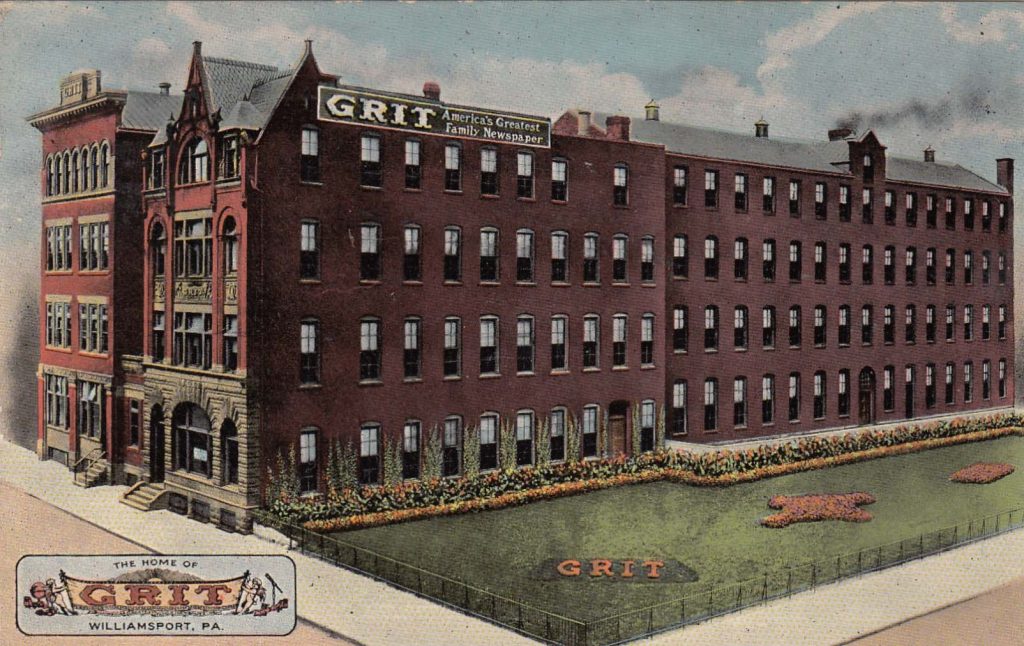
colored view shows the “Home of Grit, Williamsport, PA.”
* * *
The key to Grit’s marketing success was its sales agents, a veritable army of young boys between age 12 and 14 who sold Grit on commission in their hometowns. There are postcards that show how Grit went about exhorting the salesboys by telling them that “Selling Grit gives you valuable experience and helps fit you for a business career.” “The other boys who have succeeded as Grit agents are just ordinary fellows—but they had PLUCK. That’s the only thing you need to make the start. And, as soon as you do start, we shall stand right back of you with our help. We shall tell you how to go about selling Grit so as to be most sure of making good.”
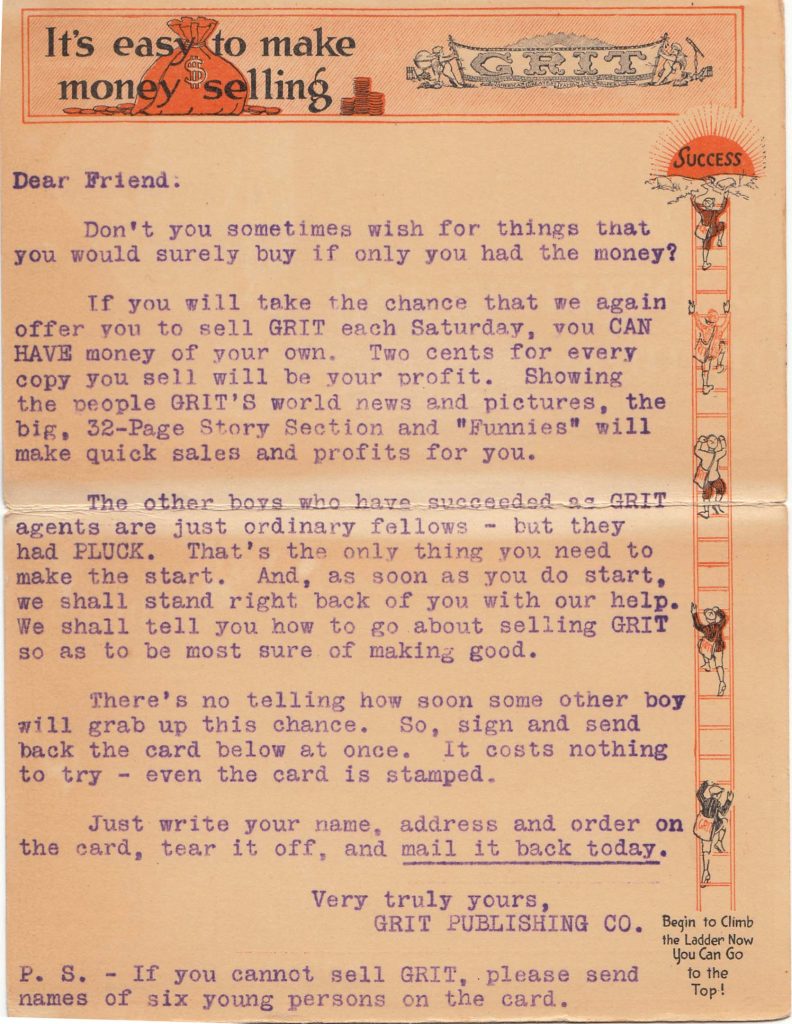
The publisher’s arrangement with his sales agents was a simple one. A boy (apparently during the early decades of the century it was only boys) could simply asked to be appointed “Local Selling Agent,” promising to “do my best to sell every copy sent me at five cents each, and will report and remit to you on the required day each month three cents for each copy sold, and return the headslips of the unsold copies.” Each boy could request a particular number of copies.
Although these postcards do not explain the process, Grit agents also had a chance to win fine prizes — watches, air rifles, cameras, flashlights, and other appropriate boy-toys.
Probably the prizes were sales incentives, awarded to those who proved to be super sales boys.
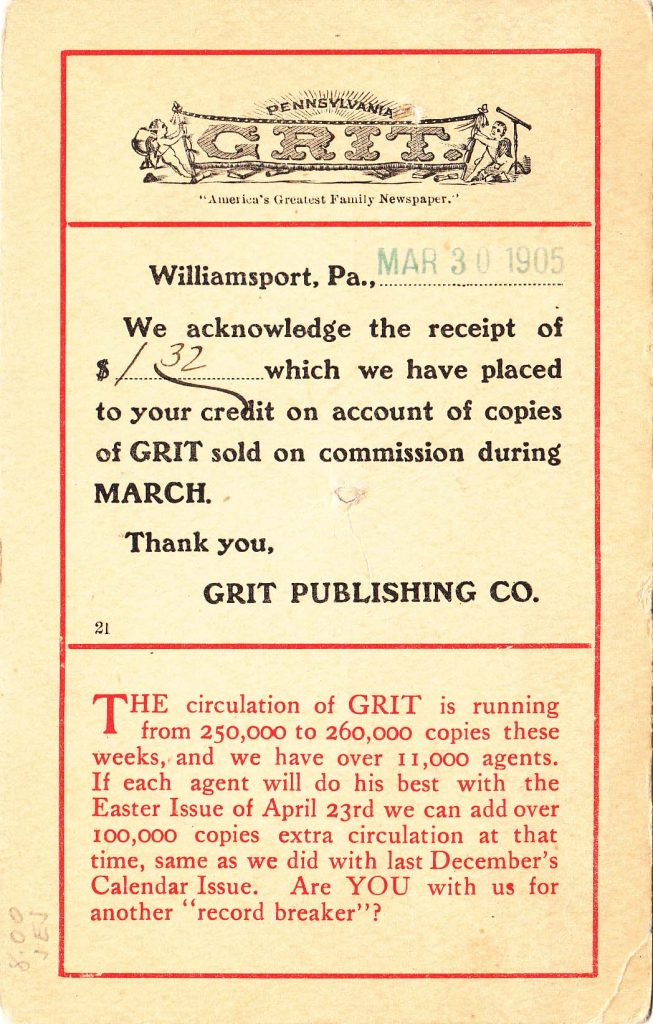
All the arrangements between Grit and its local agents were handled by mail. This is an example of the monthly acknowledgement postcard that Grit used to contact its sales force. Postally used in March 1905, this card acknowledges receipt of $1.32 from Theo F. Miles in Mortonville, Pennsylvania. At three cents a copy, Theo, sold 44 copies of Grit that March (March 1905 had four Saturdays, so Theo, sold 11 copies of Grit each week). As this card indicates, Grit was selling between 250,000-260,000 copies each week in 1905 through over 11,000 agents. For the Easter issue, Grit had hoped to sell over 100,000 extra copies. It seems Grit would substantially increase print runs on holidays.
Adults had a hand in this sales process too, you could nominate a boy and then you promised to give the boy “occasional advice and encouragement, should he need it.” Adults were entitled to a free six-month subscription if they promised.
The distribution arrangement established in the late 1880s continued to function for the next 80 or more years. By 1962, Grit had 30,000 sales agents who were recruited mostly from advertisements in Grit, Boy’s Life, and Junior Scholastic. By then, the boys kept five cents of the 15-cent price of the paper and earned an average of between $1 to $5 a week. The boys had to be at least 12 years of age and, according to the circulation director at that time, were “over the hill” at the age of 14. The time span made some sense. By age 14, boys who needed or wanted to work, could find jobs that paid more than he could earn selling newspapers. The turnover in the sales force was tremendous, and the Grit’s circulation staff was kept busy trying to recruit new boys.
Not surprisingly, the all-boy sales staff disappeared, to be replaced by the non-gender specific “Young Merchants Program.” Soon it became impossible to recruit enough young boys and girls, so in the 1980s the company switched to mail subscriptions.
* * *
Circulation peaked in 1962 when the company claimed 1.5 million subscribers (although an article written in a business publication in 1962 placed the figure at just over 900,000). By 1982, the company reported distribution of about 650,000 copies.
Grit attributed much of its sales decline to the loss of its network of sales agents. By the 1980s, teenagers could choose to work in fast food restaurants for far more money than they could earn selling Grit door-to-door. When the shift to mail subscriptions began, the company hoped to rebuild its customer base. James Crossley, then president of the company, predicted in 1982 that Grit‘s circulation would rise to one million by 1984. In fact, Grit never regained such large numbers.
* * *
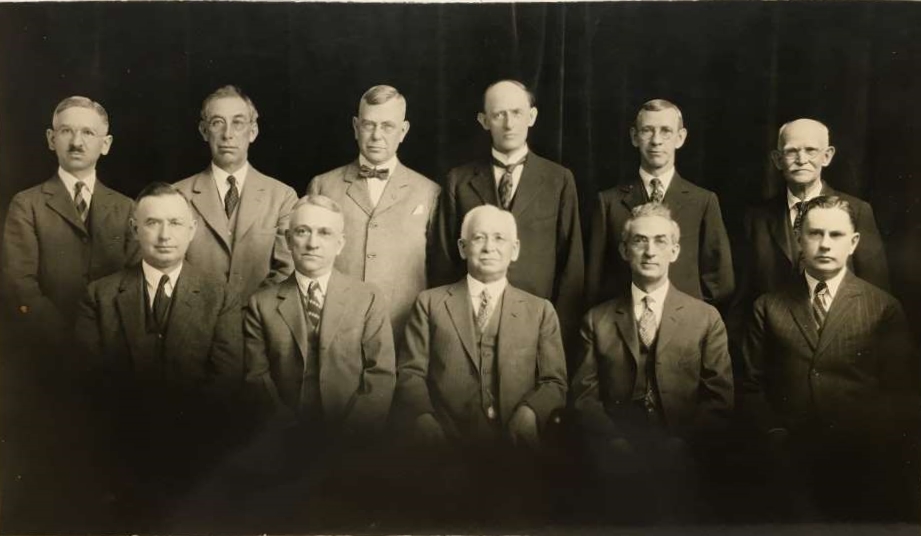
Dietrick Lamade, the founder of Grit, died in 1938, and the business was carried on by his sons George and Howard. However in 1981 the Lamade family sold the paper to ADVOSystems of Hartford, Connecticut, a direct-mail advertising firm. In 1982, a separate edition, the Sunday Grit was spun off as a local newspaper to serve the Williamsport area. In 1983, the firm was sold again, this time to Stauffer Communications, a media company based in Topeka, Kansas, which owned 20 daily newspapers, five radio stations, and two television stations operating in ten different states.
* * *
The philosophy of Grit, from the first, was embodied in a series of statements made by founder Lamade and often quoted in articles about the newspaper. “Always keep Grit from being pessimistic,” Lamade insisted. “Inform, entertain, teach and inspire.” “Let us do nothing,” he added, “that will encourage fear, worry, temptation, or other forms of weakness.” “Let us make every issue of Grit ring the joy bells of life.”
In the 1960s, then editor Kenneth D. Rhone observed, “We keep Grit on a high moral plane, and anyone in the family can read it without being offended.” The newspaper proclaimed itself, “An elevating, refining force, devoted to the best interests and welfare of the American people. It seeks to inform, entertain, teach highest moral and social principles, improve thought and inspire achievement.”
Grit still concentrates on informing, entertaining, teaching, and inspiring. As a subscriber to Grit, I once received a “prize eligibility verification” letter signed by Shirley Ingraham, of Grit customer service. Her letter reminded me that “Grit is the one publication that gives you good news, week after week, all year long.” She continued, “As a subscriber, you know that Grit is the kind of publication you and your family prefer. No sensationalized headlines; no stories of big city crime, or family turmoil. Grit covers the GOOD NEWS, the happy and helpful events that reflect the true heartland of America,” and its honest, hard-working people and their small-town values.
* * *
Meet the Sales Staff
Real photos of Grit sales boys with their distinctive Grit paperbag.
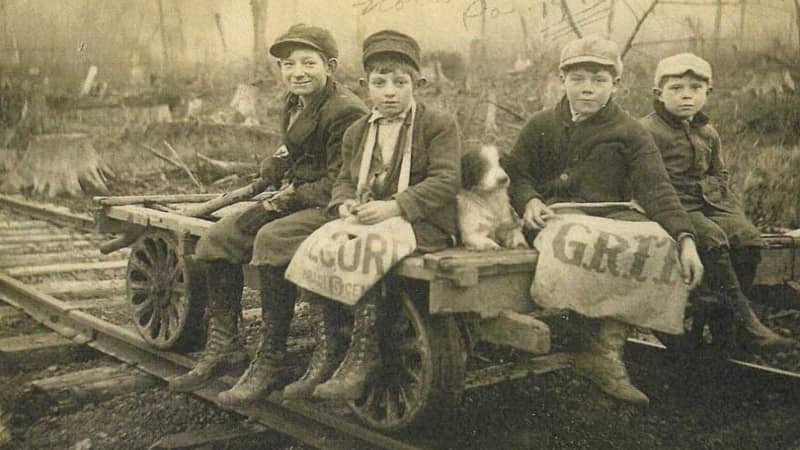
It was likely that shipments of Grit arrived in rural areas by rail. This delightful real photo card shows four eager salesboys awaiting their weekly supply of Grit.
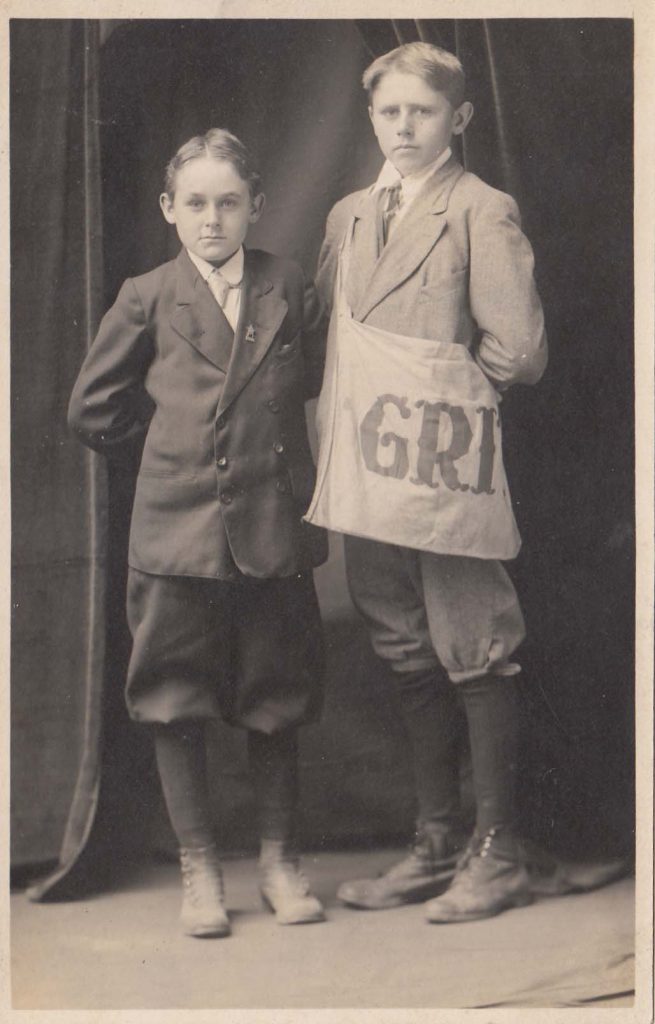
Grit sales boys didn’t dress in their Sunday best to sell newspapers, but the newspapers usually arrived in rural areas on the Sunday morning train.
Boys would pick up their weekly shipment of newspapers on their way home from church. They may even has sold a few copies by the time they got home.

This young lad in this real-photo card has been identified as Cecil Hitchcox of Bledsoe County, Tennessee.
Cecil was born in 1908, the first son of John and Lizzie (nee Tate) Hitchcox. Cecil’s father was a rural-mail carrier. The photo makes him appear to be nine or ten years old, although the minimum age was supposed to be twelve.
Cecil married Velma Smith around 1938 and later became an officer with the Tennessee Highway Patrol. In the 1930s he served as a county sheriff (see note below) and after his retirement from policing he served his hometown as their postmaster.
When Cecil registered for the draft in October 1940, he was described as having blond hair and blue eyes, standing five feet, nine inches tall.
Cecil was a true American in service to his nation and his neighbors. He passed away in 1983.
* * *
NOTE: The unexpected oddity is very common in genealogy research, and some are quite amusing. The case of Sheriff Hitchcox is a great example. On April 16, 1940, the day on which the Sixteenth Census of the United States was enumerated by Catherine S. Colunard, she found Sheriff Cecil Hitchcox on Spring Street in Pikeville Township in Bledsoe County, Tennessee. The sheriff was listed with his wife Velma and his brother on lines 16, 17, and 18 on Page 10A. On the next eleven lines of that census page were the names of eleven men between the ages of 17 and 62. Strangely there were no notations made in the “relationship” to head of household column that at first glance made it appeared that Cecil Hitchcox was responsible for a family of 13 persons. But on further examination of the page a note at the top of the page listed those on line 19 through 29 as inmates of the Bledsoe County Jail.
More proof that Cecil Hitchcox served his neighbors in many ways – even as their warden.
I remember the Grit we got in our small NJ town around 1950. I always wondered what the devil “Salve” was.
When I was of the right age, one of my classmates attempted to sell Grit, but I don’t remember him having much success. I do recall asking if he had a sample copy he could give me.
Another fine article! In the 1960’s some other outfit solicited young boys to sell their products. I can’t remember the name, but the products were greeting cards. I seem to remember ads in copies of “Boy’s Life” with an array of merchandise one could obtain depending on the amount of product sold.
My family is from Central Pennslvania and I know Grit was always on the lamp table at my grandparents’ house in Pine Grove. I was a subscriber at some point as well. I really miss publications like this and Workbasket that gave so much for so little.
An uncle delivered the Grit in the 1930’s, before my time. In the ‘40’s and early ‘50’s our oldest brother did the same. Growing up I always looked forward to reading that paper.
We lived in a rural community in south Louisiana known as Indian Bayou with the closest town about eight miles away. We had a few ole country stores in the community but no regular newspaper. The Grit was our ‘paper of choice’, for sure.
It was a great read.
Ted Boulet, Humble, Texas